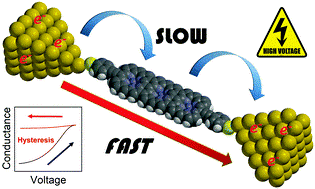RESEARCH PROGRAMMES
P2: Fundamental properties of 2D materials
P5: Solid state Quantum devices for information technologies
RESEARCH SUPERVISOR(S)
Dr Edmund Leary
Dr M. Teresa González
Research Group website: https://nanociencia.imdea.org/molecular-electronics-laboratory/group-home
RESEARCH TOPIC DESCRIPTION
Organic molecules are interesting candidates for spintronic applications due to their low spin-orbit interaction when compared to metals and semiconductors, which translates into long spin lifetimes. The possibility to control the magnetic state of individual molecules within a junction would open the door towards fabrication of magnetically-controllable nanodevices of great interest for emerging quantum information technology.
The Molecular Electronics Laboratory at IMDEA Nanociencia has vast experience in studying the electrical properties of single-molecule junctions by way of scanning tunneling microscopes (STM). Our in-house developed STMs allow us to explore not only the conductance but also the thermopower of a variety of compounds. We have recently incorporated an electrochemical cell allowing us to gate our devices electrochemically. Examples of the systems we have explored recently include: Cumulenes,1 length-dependent behavior and charging phenomena in porphyrins,2–4 aromaticity/antiaromaticity in azaborine5 or dibenzo pentalenes,6 quantum interference in fluorenes and fluorenones7 as well as developing theoretical models to understand such effects,8 charge-assisted hydrogen bonded molecular junctions.9
We want to use STM operating at room temperature to study single-molecule junctions of compounds relevant for spintronic applications using magnetic electrodes (Ni or Fe for example). We will use the electrochemical chamber to remove oxide from the electrode surface to allow the magnetic molecules to bind correctly to the magnetized electrodes. Regarding the compounds of interest, initial candidates to investigate are: mercaptopyridine-Fe complexes and chiral sulfoxide derivatives, synthesized Jose Sánchez Costa (IMDEA) and Juan Manuel Cuerva (Granada University) respectively. We also have the ability to oxidise/reduce a molecule temporally using the bias voltage which gives us another avenue to obtain (magnetic) molecules with unpaired electrons.
1. Xu, W. et al. Unusual Length Dependence of the Conductance in Cumulene Molecular Wires. Angew. Chem. Int. Ed. 58, 8378–8382 (2019).
2. Leary, E. et al. Bias-Driven Conductance Increase with Length in Porphyrin Tapes. J. Am. Chem. Soc. 140, 12877–12883 (2018).
3. Leary, E. et al. Detecting Mechanochemical Atropisomerization within an STM Break Junction. J. Am. Chem. Soc. 140, 710–718 (2018).
4. Leary, E. et al. Long-lived charged states of single porphyrin-tape junctions under ambient conditions. Nanoscale Horiz 6, 49–58 (2021).
5. Palomino-Ruiz, L. et al. Single-Molecule Conductance of 1,4-Azaborine Derivatives as Models of BN-doped PAHs. Angew. Chem. Int. Ed. 60, 6609–6616 (2021).
6. Schmidt, M. et al. Single-molecule conductance of dibenzopentalenes: antiaromaticity and quantum interference. Chem Commun 57, 745–748 (2021).
7. Alanazy, A. et al. Cross-conjugation increases the conductance of meta-connected fluorenones. Nanoscale 11, 13720–13724 (2019).
8. Zotti, L. A. & Leary, E. Taming quantum interference in single molecule junctions: induction and resonance are key. Phys Chem Chem Phys 22, 5638–5646 (2020).
9. Sacchetti, V. et al. Effect of Charge-Assisted Hydrogen Bonds on Single-Molecule Electron Transport. J. Phys. Chem. C 123, 29386–29393 (2019).
POSITION DESCRIPTION
A typical background would be in Chemistry, Physics or Engineering with previous knowledge in: electrochemistry, nanoelectronics or spintronics; scientific acquisition/analysis programs (such as Labview or Matlab); programming skills with these or other programs.
PARTNER ORGANIZATIONS
Ongoing collaborations with synthetic chemistry groups include Prof. Nazario Martín and José Sánchez Costa at IMDEA Nanociencia, Juan Manuel Cuerva and Araceli G. Campaña at the University of Granada, Harry Anderson at the University of Oxford (UK), Rik Tykwinski at the University of Alberta (Canada) and Birgit Esser at the University of Freiburg (Germany). We also collaborate with a variety of theoreticians including Fernando Martín (IMDEA Nanociencia), Linda Zotti (Autonomous University of Madrid), Colin Lambert (University of Lancaster, UK) and Fabian Pauli (University of Augsburg, Germany). We also collaborate with the groups of Walther Schwarzacher at Bristol University and Richard Nichols at the University of Liverpool in the UK regarding the electrochemical set up.


